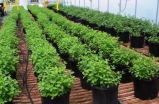(Press-News.org) University of British Columbia researchers have identified a small virus that attacks another virus more than 100 times its own size, rescuing the infected zooplankton from certain death. The discovery provides clues to the evolutionary origin of some jumping genes found in other organisms.
The study, by UBC marine microbiologist Curtis Suttle and PhD student Matthias Fischer, is published online today in Science Express. It describes the marine virus Mavirus and its interaction with marine zooplankton Cafeteria roenbergenesis and CroV, the world's largest marine virus.
"It's a microbial version of the David and Goliah story where, after infecting Cafeteria roenbergeneis, Mavirus protects it against infection by CroV, while ensuring its own survival," says Suttle.
Viruses rely on host cells to replicate; in the case of Mavirus, its host is another virus, making it only the second known virophage. It needs CroV to replicate, and in the process suppresses the propagation of CroV.
"What makes this interaction significant to evolutionary biology is that the closest genetic relatives to Mavirus are mobile genetic elements found in single-celled and higher organisms," says Suttle. "This implies that over evolutionary time, organisms have co-opted the DNA from ancient relatives of Mavirus into their own genomes, presumably so that they could acquire immunity against giant viruses like CroV.
Transposons, or jumping genes, are bits of DNA that can move or "transpose" themselves to new positions within an organism's genome. Researchers have suspected that a subset of transposons – called Maverick transposons – have a viral origin because of the nature of their DNA sequences.
Suttle and Fischer's latest work on Mavirus provides the first concrete evidence of this connection.
"Because they've sequestered the virophage DNA into their own genomes, organisms probably don't need to rely on being infected by a second virus to protect themselves," says Suttle.
Suttle and Fischer previously identified CroV as the world's largest marine virus, with a complex genome that has made it remarkably independent of its host cells.
### END
'David and Goliath' viruses shed light on the origin of jumping genes: UBC study
2011-03-04
ELSE PRESS RELEASES FROM THIS DATE:
Bieber's Golden Locks Bought by GoldenPalace.com for Over $40,000
2011-03-04
Following a week of intense bidding, the auction for Justin Bieber's hair closed today with a final winning bid from GoldenPalace.com. The popular online casino spent $40,668.00 to lock down the teen singing phenom's famous locks with all proceeds going to support The Gentle Barn Foundation.
The idea for the auction began when The Biebs paid a surprise visit to Ellen DeGeneres during the taping of her show in February. The 53-year-old talk show host had recently tweeted that she wanted a lock of Bieber's hair for her birthday. Never one to disappoint a belieber, Justin ...
Chicken litter provides organic alternative to synthetic fertilizers
2011-03-04
CRYSTAL SPRINGS, MS—Recent movements aimed at managing environmental impacts of agriculture have spurred interest in the development and use of organic and natural fertilizers for commercial applications. Many organic fertilizers are byproducts of livestock, fish, food, and other processing industries. In Mississippi, where the poultry industry produces more than 730 million broiler chickens each year, and annual chicken litter production is estimated at more than 730,000 tons, there is a naturally abundant supply of chicken litter available for fertilizer.
New research ...
Using wastewater to enhance mint production
2011-03-04
SOUTH VERONA, MS—When essential oils are extracted from plants through the process of steam distillation, wastewater is produced and subsequently released into rivers and streams. Finding new uses for these unused by-products could benefit essential oil crop growers and processors as well as the environment. A team of researchers has found that the residual distillation water of some aromatic plant species has a beneficial effect on yields and can increase essential oil content of peppermint and spearmint crops.
Peppermint and spearmint are commercially produced for their ...
Researchers find possible new treatment strategies for pancreatic cancer
2011-03-04
Athens, Ga. – New University of Georgia research has identified a protein that can be modified to improve the effectiveness of one of the most common drugs used to treat pancreatic cancer.
The research, published in the March edition of the journal Cancer Research, found that a cell-surface protein called CNT1, which transports cancer-killing drugs into tumor cells, was reduced in function in two thirds of pancreatic tumors. By improving the function of CNT1, the researchers increased the effectiveness of the cancer-killing drugs in pancreatic tumor cells derived from ...
Feet first? Old mitochondria might be responsible for neuropathy in the extremities
2011-03-04
The burning, tingling pain of neuropathy may affect feet and hands before other body parts because the powerhouses of nerve cells that supply the extremities age and become dysfunctional as they complete the long journey to these areas, Johns Hopkins scientists suggest in a new study. The finding may eventually lead to new ways to fight neuropathy, a condition that often accompanies other diseases including HIV/AIDS, diabetes and circulatory disorders.
Neuropathies tend to hit the feet first, then travel up the legs. As they reach the knees, they often start affecting ...
Doctors lax in monitoring potentially addicting drugs
2011-03-04
March 3, 2011 — (BRONX, NY) — Few primary care physicians pay adequate attention to patients taking prescription opioid drugs — despite the potential for abuse, addiction and overdose, according to a new study by researchers at Albert Einstein College of Medicine of Yeshiva University.
The study, published in the March 2 online edition of the Journal of General Internal Medicine, found lax monitoring even of patients at high risk for opioid misuse, such as those with a history of drug abuse or dependence. The findings are especially concerning considering that prescription ...
Method developed to match police sketch, mug shot
2011-03-04
The long-time practice of using police facial sketches to nab criminals has been, at best, an inexact art. But the process may soon be a little more exact thanks to the work of some Michigan State University researchers.
A team led by MSU University Distinguished Professor of Computer Science and Engineering Anil Jain and doctoral student Brendan Klare has developed a set of algorithms and created software that will automatically match hand-drawn facial sketches to mug shots that are stored in law enforcement databases.
Once in use, Klare said, the implications are ...
AgriLife Research scientists trumpeting possible new adaptation of tropical flower
2011-03-04
VERNON – Texas AgriLife Research scientists are trying to bring more beauty to the colder regions of the state by breeding winter-hardiness into a tropical ornamental plant, the angel's trumpet flower.
Dr. Dariusz Malinowski, AgriLife Research plant physiologist and forage agronomist in Vernon, along with Dr. Bill Pinchak and Shane Martin, both with AgriLife Research, and Steve Brown, program director for Texas Foundation Seed Service, began the project three years ago.
The goal of the project is to develop new cultivars with a range of flower colors, shapes and size, ...
New study to look at economics, groundwater use of bioenergy feedstocks
2011-03-04
AMARILLO – Biofuel feedstock production in the Texas High Plains could significantly change the crop mix, which could affect regional income and groundwater consumption, according to Texas AgriLife Research and Texas AgriLife Extension Service economists.
Dr. Steve Amosson, AgriLife Extension economist in Amarillo, and Dr. Seong Park, AgriLife Research economist in Vernon, are joining other economists to model the socio-economic effects of climate change on the Ogallala Aquifer.
The project, Economics and Groundwater-Use Implications of Bioenergy Feedstocks Production ...
Scripps Research scientists create cell assembly line
2011-03-04
JUPITER, FL, March 3, 2011 – Borrowing a page from modern manufacturing, scientists from the Florida campus of The Scripps Research Institute have built a microscopic assembly line that mass produces synthetic cell-like compartments.
The new computer-controlled system represents a technological leap forward in the race to create the complex membrane structures of biological cells from simple chemical starting materials.
"Biology is full of synthetic targets that have inspired chemists for more than a century," said Brian Paegel, Scripps Research assistant professor ...


